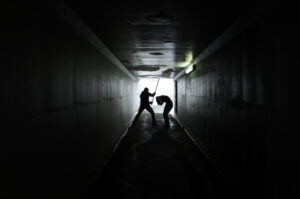California’s most powerful earthquake ever struck Fort Tejon, a place near the San Andreas Fault. The quake’s epicenter was some distance north of Fort Tejon and the scar it left alongside the San Andreas Fault was two hundred miles long.
On January 9, 1857, California’s greatest ever earthquake struck the central part of the state near the San Andreas Fault. It left a surface scar of more than two hundred miles along the line of the fault and caused a horizontal displacement as large as thirty feet. Its magnitude was 7.9. The Owens Valley Earthquake and the great San Francisco event of 1906 make up, with Fort Tejon, California’s three biggest historical earthquakes. The 1906 San Francisco guake was 7.8 and that in Owens Valley was 7.4. The epicenter of the 1857 event was not at Fort Tejon but rather about sixty miles farther north but, because Fort Tejon was a well-known place in a thinly populated area, the earthquake was named after it. The earthquake itself caused one fatality, evidence of the low density of population. If we compare San Francisco in 1906 with Fort Tejon in 1857, the break in the San Andreas Fault was longer in the former but the maximum and average displacements were larger in the latter.
The effects of the quake were quite dramatic, even frightening. Were the Fort Tejon shock to happen today in the context of present population, the damage would run into billions of dollars, and the loss of life would be substantial. In 1857, the population density was extremely low and native people were the principal residents. When the earthquake actual hit strong shaking ensued, which lasted from one to three minutes. Property loss was heavy at Fort Tejon as five buildings were severely damaged and several others sustained moderate damage. Trees were uprooted and fish were thrown out of Tulare Lake. Ground fissures appeared in the beds of several rivers and evidence of liquefaction was found between Stockton and Sacramento. Additionally, there were two significant aftershocks within a week of the main event. Ground openings and fissures were reported from Sacramento to the delta of the Colorado River and changes in the flows of rivers occurred in several locations. In Los Angeles, a city of 4,000 people at that time, minor damage was done to homes.
The San Andreas Fault extends for more than eight hundred miles from the northern Californian coast to the Gulf of California. It is at the heart of almost all California’s earthquakes. Interaction between the North American and Pacific plates along this fault takes place within an elongate zone, broadening from sixty miles at its north end to three times that width in southern California. The fault is close to the east side of this zone in the south and it gradually migrates across the zone, lying on the west edge at its northern end. The constant interaction between the Pacific and the North American tectonic plates takes place in opposite directions along this fault, with the Pacific Plate moving northwards and the North American Plate moving southwards, but these movements are not always smooth. Many factors interfere with their movements, including the presence of subsidiary faults, different types of rock, and the differential rates of plate movements because they are moving on the globe, a curved, not a flat surface. Much of the energy expended is, therefore, unable to do its work of moving the tectonic plate forward. It gets stored elastically, that is to say under pressure, in the upper crust of California’s bedrock, close to the fault. From time to time the fault slips, the stored energy is released, and an earthquake occurs.
California in 1857 was thinly populated with Europeans, except for the two dominant settlements, San Francisco and Sacramento. The first big gold rush of the many that would happen later in the nineteenth century— in the Klondike, Australia and South Africa—had created a feverish scramble among people everywhere to get to California and be the first finder of the mother lode, the place with the biggest gold nuggets. There were no roads or trains across the United States and the gold seekers had to find their way either across land near Panama or by sea around Cape Horn. In this year of 1857, the gold rush was in its ninth year of diggings and things were beginning to slow down. There was less and less gold to be found but, in the few years of frantic efforts to strike it rich, San Francisco had become a big city, the only big city west of the Rockies. Its population was 53,000 and the only other city, Sacramento, the state capital, had a population of 12,000. It was fortunate for us today, as we seek to understand better the huge earthquake of 1857, that there were newspaper descriptions and other reports of the event published in these two cities at the time and we can examine these accounts today. San Francisco had six newspapers at the time and Sacraments had five.
Most of these records deal with human reactions and damage to buildings, all of which were either of adobe or brick construction. In either case, in a frontier location like this, the masonry used would be weak so that minor shocks could be very destructive. From Marysville, fifty miles north of Sacramento, all the way to the southern border of the state and eastward as far as Las Vegas some level of shock was experienced. The main area affected, however, while still large, is limited to a hundred-mile stretch of territory from 34 degrees north to 36.5 degrees north. Shocks of strength 7 on the Modified Mercalli Scale were experienced everywhere within this area. Typical newspaper accounts of the shocks experienced were as follows: we all ran outside as our building cracked because we saw that others had collapsed. It was difficult to remain in a standing position. We saw men being physically thrown down by the force of the earthquake. Reports by those who were close to the epicenter of the quake described homes collapsing and trees being knocked down. Everywhere, people were afraid. They did not have our present knowledge of earthquakes so, understandably, they had no idea what might happen next.
The intensity experienced in Los Angeles, at that time a pueblo in the location we know today as downtown, was described as moderate. People were frightened but the only damage to buildings was the cracking of walls. It was a similar level of shock in San Bernardino and Santa Barbara. From data such as these it is reasonable to conclude that a repeat of the 1857 earthquake today would not cause serious damage to low-rise buildings in Los Angeles. There were many mild aftershocks to this momentous earthquake of 1857 but among them two seemed to have been sufficiently strong to attract the attention of several newspapers. One occurred on the evening of the day of the main shock. The second one arrived a week later. Both were described as severe but there was no record of damage. The duration of each of these two strong aftershocks was short, much less than the timing of the main shock, and they continued for three minutes in San Bernardino and two minutes in Fort Tejon.
The close link between the 1857 and 1906 earthquakes, coupled with the growing body of research findings on previous powerful quakes along the San Andreas Fault, has given rise to calculations and possible predictions about the future. When might another magnitude 8 earthquake occur here? That question has occupied the minds of many geologists. One of the first pointers to an answer came with investigations of past quakes. One geologist used evidences of past displacements on the fault, deformations of the crust, and distances between the two tectonic plates that move on opposite sides of the fault to propose a timetable for the future. His calculations were based on a time period of twenty million years so many of his colleagues treated his estimates as very-long-predictions; that is to say, estimates that might prove to be statistically good but incapable of giving much guidance for the immediate future. His prediction was that another large earthquake would occur at intervals of from fifty to two hundred years. Another researcher, Kerry E. Sieh of the California Institute of Technology, focused his investigations in one place, the same area affected by the 1857 quake, and examined the earth’s crust vertically rather than horizontally as was done by the geologist who considered the past twenty million years.
Sieh discovered evidence of at least nine earthquakes over the past 1,400 years. Later, as he continued his investigations, he expanded the number to twelve. Based on these findings that cover a relatively short time, geologically speaking, he concluded that the average recurrence interval would be between 140 and 150 years. His work was carried out in the mid 1970s and many scientists commented on his findings in later years. In 1985, for example, two geologists wrote a major article on predicting future San Andreas earthquakes in the journal Scientific American. They noted that the time interval from the 1857 earthquake was 128 years at the time of their writing and added that this figure was alarmingly close to Sieh’s estimate for a recurrence. More than twenty years after the publication of their article, the San Andreas Fault still awaits its next magnitude 8 event. These two attempts, one looking back twenty million years and the other 1,400 years, are a useful reminder of the great difficulties in predicting earthquakes. Nevertheless, the attempts continue and, as mentioned in the introduction, they have expanded in China and Japan to observations of the behavior of wildlife just prior to earthquakes.
Sieh’s findings were incorporated into the prediction that the Geological Survey was asked to provide to the National Security Council. Preparations have to be made in anticipation of future earthquakes even if there is no certainty about specific dates. These preparations take account of all kinds of data in the hope that they will, one day, be able to anticipate a catastrophic earthquake. Experts know, just to add another item of information to what they already have, that strain accumulates on the San Andreas Fault at a rate of a little more than an inch a year. Thus, if one were to calculate the strain since 1857, it would amount to twelve and a half feet by the year 2007. Deductions from such data as well as from the earlier ones are not reliable. Even when the recurrence rate of a major event in the San Andreas Fault is known, activities in other domains may disrupt our calculations. Slight changes in the earth’s rotation or in its normal distance from the sun can change the behavior of the tectonic plates that are a vital causal factor in California’s earthquakes. The massive Indonesian earthquake of December, 2004, was sufficiently powerful to do what had never before been observed in human history. It slowed down for a fraction of a second the earth’s rate of rotation.
The value of knowing when the next earthquake may strike becomes more and more important with the passage of time. There are so many elements of our total environment that human society can now control, and so much technology with which we can do what is needed, that the quest for answers to earthquake prediction must be pursued. In 1857, the total population of California was not much more than 10,000, perhaps not even as great as that. In the early years of the present century its population is thirty-five million and growing at a rate that is above the national average. It added fifteen million since 1970. Today, a single county may be the custodian of most of the nation’s wealth. Santa Clara County suffered heavy damage in the 1906 earthquake; today it is the principal home to the nation’s supplies of semi-conductors. Urbanization has added its own urgency to the demand for earthquake prediction. Most of the state’s people live in cities and San Francisco is now a huge urban agglomeration, not just a single city as it was in 1906. There are estimates of casualties if a magnitude 8 quake should hit the San Andreas Fault within the next decade. They vary according to the time of day that such an event occurred. At two in the morning it would be over 13,000 and proportionately less at various other times of day.






















